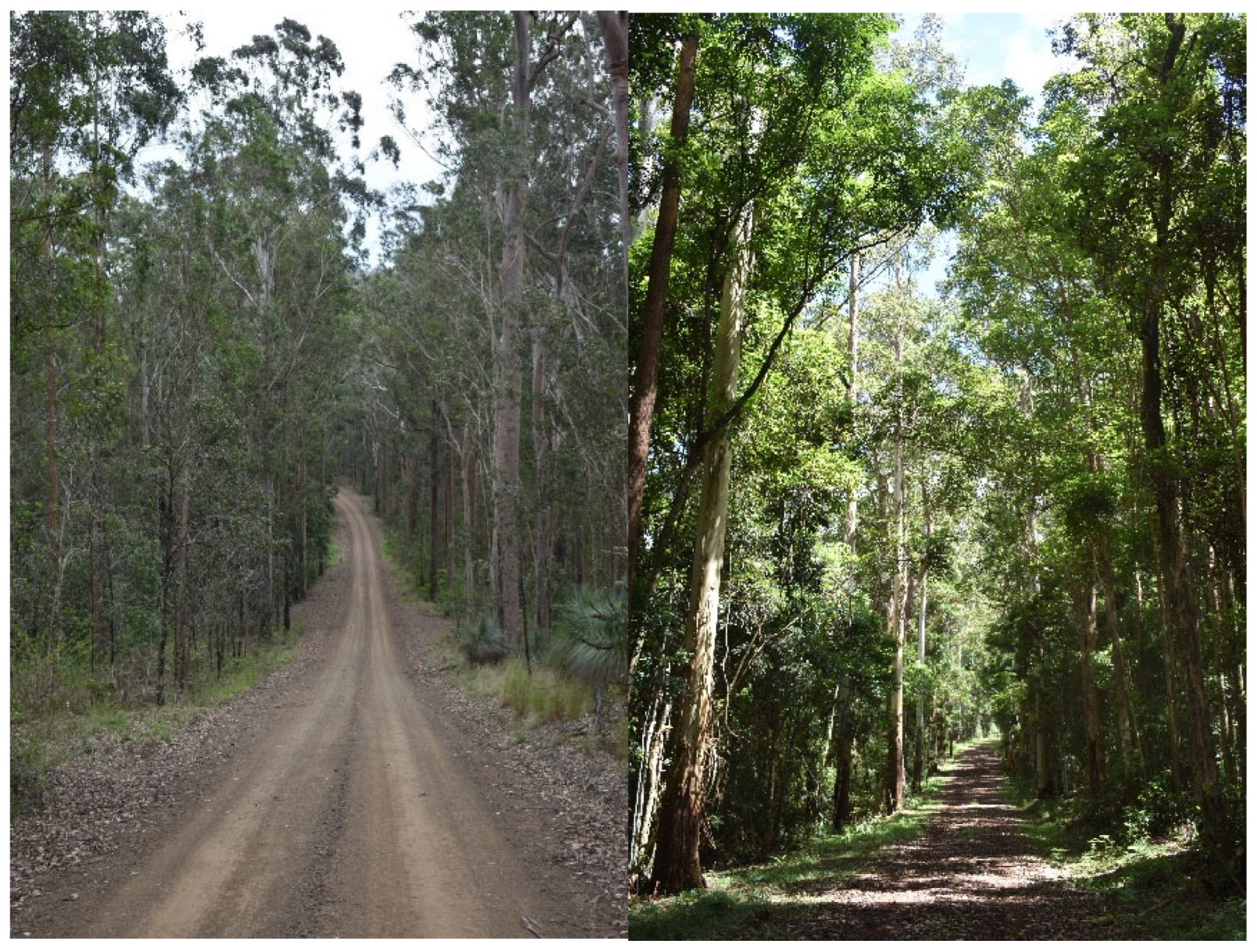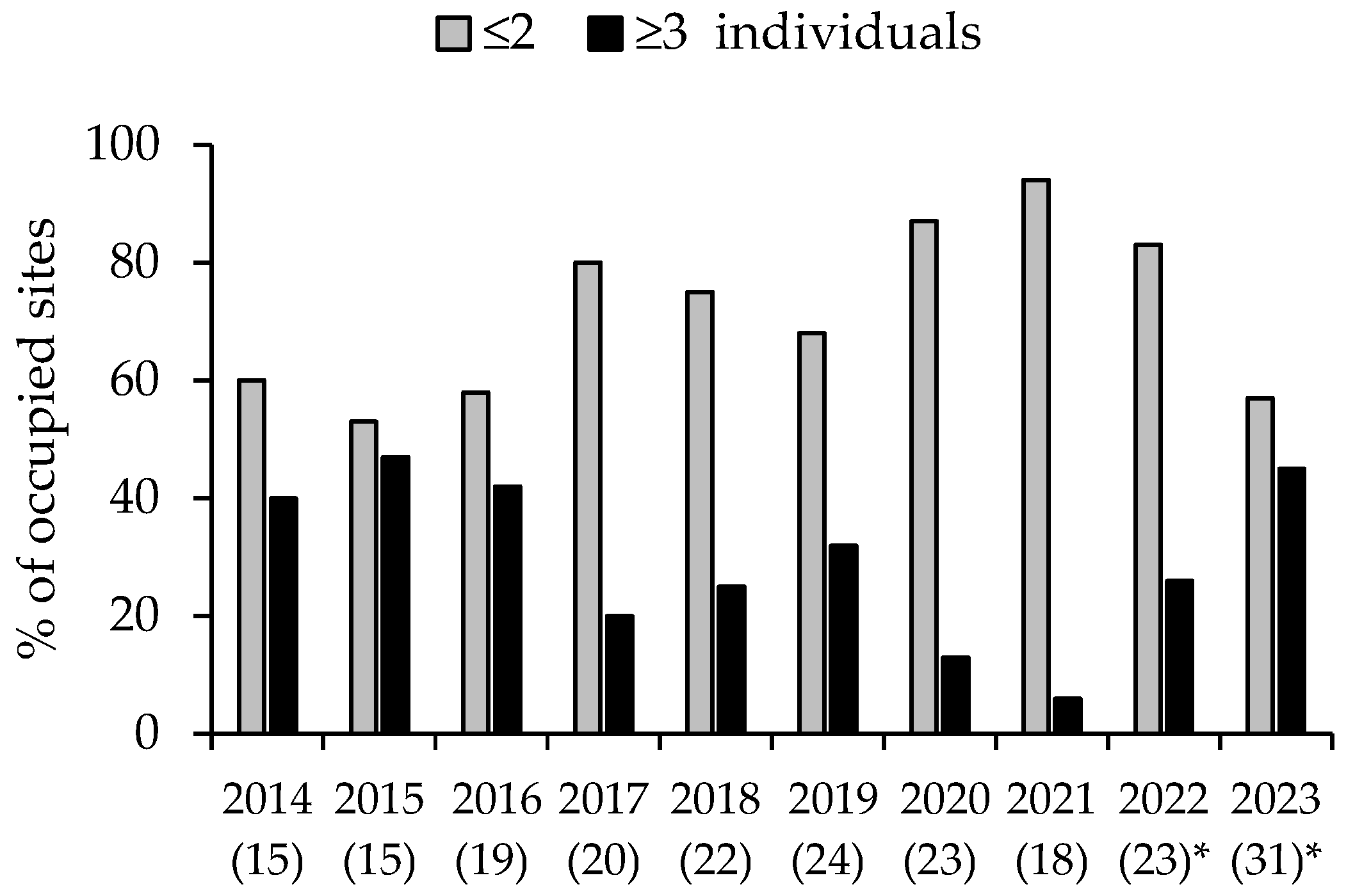Recovery Following a Drought-Induced Population Decline in an Exudivorous Forest Mammal
Abstract
1. Introduction
2. Materials and Methods
2.1. Study Area
2.2. Animal Surveys
2.3. Multi-Season Occupancy Analysis
2.4. Ethics Statement
3. Results
3.1. Animal Detections and Occupancy
3.2. Animal Abundance
4. Discussion
4.1. Population Monitoring
4.2. Life History Traits
4.3. The Influence of Diet
4.4. Limitations of This Study
4.5. Implications
5. Conclusions
Supplementary Materials
Funding
Data Availability Statement
Acknowledgments
Conflicts of Interest
References
- Gordon, G.; Brown, A.S.; Pulsford, T. A koala (Phascolarctos cinereus Goldfuss) population crash during drought and heatwave conditions in south-western Queensland. Aust. J. Ecol. 1988, 13, 451–461. [Google Scholar] [CrossRef]
- Young, T.P. Natural die-offs of large mammals: Implications for conservation. Conserv. Biol. 1994, 8, 410–418. [Google Scholar] [CrossRef]
- Fisher, D.O.; Blomberg, S.P.; Hoyle, S.D. Mechanisms of drought-induced population decline in an endangered wallaby. Biol. Conserv. 2001, 102, 107–115. [Google Scholar] [CrossRef]
- Godfree, R.C.; Knerr, N.; Godfree, D.; Busby, J.; Robertson, B.; Encinas-Viso, F. Historical reconstruction unveils the risk of mass mortality and ecosystem collapse during pancontinental megadrought. Proc. Natl. Acad. Sci. USA 2019, 116, 15580–15589. [Google Scholar] [CrossRef] [PubMed]
- Bourne, A.R.; Cunningham, S.J.; Spottiswoode, C.N.; Ridley, A.R. Hot droughts compromise interannual survival across all group sizes in a cooperatively breeding bird. Ecol. Lett. 2020, 23, 1776–1788. [Google Scholar] [CrossRef] [PubMed]
- Campos-Cerqueira, M.; Aide, T.M. Impacts of a drought and hurricane on tropical bird and frog distributions. Ecosphere 2021, 12, e03352. [Google Scholar] [CrossRef]
- Kothavala, Z. The duration and severity of drought over eastern Australia simulated by a coupled ocean–atmosphere GCM with a transient increase in CO2. Environ. Model. Softw. 1999, 14, 243–252. [Google Scholar] [CrossRef]
- Dai, A. Increasing drought under global warming in observations and models. Nat. Clim. Change 2013, 3, 52–58. [Google Scholar] [CrossRef]
- Diffenbaugh, N.S.; Swain, D.L.; Touma, D. Anthropogenic warming has increased drought risk in California. Proc. Natl. Acad. Sci. USA 2015, 112, 3931–3936. [Google Scholar] [CrossRef]
- Cook, B.I.; Mankin, J.S.; Marvel, K.; Williams, A.P.; Smerdon, J.E.; Anchukaitis, K.J. Twenty-first century drought projections in the CMIP6 forcing scenarios. Earth’s Future 2020, 8, e2019EF001461. [Google Scholar] [CrossRef]
- Driscoll, D.A.; Felton, A.; Gibbons, P.; Felton, A.M.; Munro, N.T.; Lindenmayer, D.B. Priorities in policy and management when existing biodiversity stressors interact with climate change. Clim. Change 2012, 111, 533–557. [Google Scholar] [CrossRef]
- Campos, F.A.; Morris, W.F.; Alberts, S.C.; Altmann, J.; Brockman, D.K.; Cords, M.; Pusey, A.; Stoinski, T.S.; Strier, K.B.; Fedigan, L.M. Does climate variability influence the demography of wild primates? Evidence from long-term life-history data in seven species. Glob. Change Biol. 2017, 23, 4907–4921. [Google Scholar] [CrossRef]
- Paniw, M.; James, T.D.; Archer, C.R.; Römer, G.; Levin, S.; Compagnoni, A.; Che-Castaldo, J.; Bennett, J.M.; Mooney, A.; Childs, D.Z.; et al. The myriad of complex demographic responses of terrestrial mammals to climate change and gaps of knowledge: A global analysis. J. Anim. Ecol. 2021, 90, 1398–1407. [Google Scholar] [CrossRef] [PubMed]
- Healy, K.; Ezard, T.H.G.; Jones, O.R.; Salguero-Gómez, R.; Buckley, Y.M. Animal life history is shaped by the pace of life and the distribution of age-specific mortality and reproduction. Nat. Ecol. Evol. 2019, 3, 1217–1224. [Google Scholar] [CrossRef] [PubMed]
- IUCN (International Union for Conservation of Nature). The IUCN Red List of Threatened Species. 2025. Available online: http://www.iucnredlist.org (accessed on 21 May 2025).
- Morris, W.F.; Pfister, C.A.; Tuljapurkar, S.; Haridas, C.V.; Boggs, C.L.; Boyce, M.S.; Bruna, E.M.; Church, D.R.; Coulson, T.; Doak, D.F.; et al. Longevity can buffer plant and animal populations against changing climatic variability. Ecology 2008, 89, 19–25. [Google Scholar] [CrossRef]
- Promislow, D.E.L.; Harvey, P.H. Living fast and dying young: A comparative analysis of life-history variation among mammals. J. Zool. 1990, 220, 417–437. [Google Scholar] [CrossRef]
- Campos, F.A.; Kalbitzer, U.; Melin, A.D.; Hogan, J.D.; Cheves, S.E.; Murillo-Chacon, E.; Guadamuz, A.; Myers, M.S.; Schaffner, C.M.; Jack, K.M.; et al. Differential impact of severe drought on infant mortality in two sympatric neotropical primates. R. Soc. Open Sci. 2020, 7, 200302. [Google Scholar] [CrossRef]
- Department of Agriculture, Water, and the Environment [DAWE]. Conservation Advice for Petaurus australis australis (Yellow-Bellied Glider (South-Eastern)). Australian Government, Department of Agriculture, Water and the Environment: Parkes, Australia. 2022. Available online: https://www.environment.gov.au/biodiversity/threatened/species/pubs/87600-conservation-advice-02032022.pdf (accessed on 2 April 2023).
- Handayani, F.; Goldingay, R.L.; McHugh, D.; Leslie, N. Extensive range contraction predicted under climate warming for a gliding mammal in north-eastern Australia. Aust. Mammal. 2019, 41, 99–111. [Google Scholar] [CrossRef]
- Goldingay, R.L.; Parkyn, J.L.; McHugh, D. Drought-induced population decline in an exudivorous mammal and its relevance to forest management. For. Ecol. Manag. 2023, 548, 121424. [Google Scholar] [CrossRef]
- Goldingay, R.L. A review of the ecology and conservation of the yellow-bellied glider. Aust. Mammal. 2025, 47, AM24041. [Google Scholar] [CrossRef]
- Goldingay, R.L.; Kavanagh, R.P. Socioecology of the yellow-bellied glider (Petaurus australis) at Waratah Creek, N.S.W. Aust. J. Zool. 1990, 38, 327–341. [Google Scholar] [CrossRef]
- Goldingay, R.L. Loud calls of the yellow-bellied glider, Petaurus australis: Territorial behaviour by an arboreal marsupial? Aust. J. Zool. 1994, 42, 279–293. [Google Scholar] [CrossRef]
- McNabb, E.G. Predator calls and prey response. Vic. Nat. 1994, 111, 190–196. [Google Scholar]
- Kavanagh, R.P.; Rohan-Jones, W.G. Calling behaviour of the yellow-bellied glider, Petaurus australis Shaw (Marsupialia: Petauridae). Aust. Mammal. 1982, 5, 95–111. [Google Scholar] [CrossRef]
- Whisson, D.A.; McKinnon, F.; Lefoe, M.; Rendall, A.R.; Halliday, W.D. Passive acoustic monitoring for detecting the yellow-bellied glider, a highly vocal arboreal marsupial. PLoS ONE 2021, 16, e0252092. [Google Scholar] [CrossRef]
- Heise-Pavlov, S.; Prokop, C.; Goss, L. A pilot study to encode calls from the northern yellow-bellied glider. Aust. Mammal. 2024, 46, AM23026. [Google Scholar] [CrossRef]
- MacKenzie, D.I.; Nichols, J.D.; Hines, J.E.; Knutson, M.G.; Franklin, A.B. Estimating site occupancy, colonization, and local extinction when a species is detected imperfectly. Ecology 2003, 84, 2200–2207. [Google Scholar] [CrossRef]
- Burnham, K.P.; Anderson, D.R. Multimodel inference: Understanding AIC and BIC in model selection. Sociol. Methods Res. 2004, 33, 261–304. [Google Scholar] [CrossRef]
- Arnold, T.W. Uninformative parameters and model selection using Akaike’s information criterion. J. Wildl. Manage. 2010, 74, 1175–1178. [Google Scholar] [CrossRef]
- Gould, L.; Sussman, R.W.; Sauther, M.L. Natural disasters and primate populations: The effects of a 2-year drought on a naturally occurring population of ring-tailed lemurs (Lemur catta) in southwestern Madagascar. Int. J. Primatol. 1999, 20, 69–84. [Google Scholar] [CrossRef]
- Parrott, M.L.; Ward, S.J.; Temple-Smith, P.D.; Selwood, L. Effects of drought on weight, survival and breeding success of agile antechinus (Antechinus agilis), dusky antechinus (A. swainsonii) and bush rats (Rattus fuscipes). Wildl. Res. 2007, 34, 437–442. [Google Scholar] [CrossRef]
- Henry, S.R.; Craig, S.A. Diet, ranging behaviour and social organization of the yellow-bellied glider (Petaurus australis) in Victoria. In Possums and Gliders; Smith, A.P., Hume, I.D., Eds.; Australian Mammal Society: Sydney, Australia, 1984; pp. 331–341. [Google Scholar]
- Craig, S.A. Social organization, reproduction and feeding behaviour of a population of yellow-bellied gliders, Petaurus australis (Marsupialia: Petauridae). Wildl. Res. 1985, 12, 1–18. [Google Scholar] [CrossRef]
- Russell, R. Social behaviour of the yellow-bellied glider, Petaurus australis, in north Queensland. In Possums and Gliders; Smith, A.P., Hume, I.D., Eds.; Australian Mammal Society: Sydney, Australia, 1984; pp. 345–353. [Google Scholar]
- Gonsalves, L.; Law, B.; Slade, C. Landscape-scale monitoring for forest fauna is achievable: A case study using remote sensors, artificial intelligence and robust analytics. Aust. Zool. 2024, 43, 526–544. [Google Scholar] [CrossRef]
- Purvis, A.; Gittleman, J.L.; Cowlishaw, G.; Mace, G.M. Predicting extinction risk in declining species. Proc. R. Soc. Lond. B 2000, 267, 1947–1952. [Google Scholar] [CrossRef] [PubMed]
- Davey, S.M. Methods for surveying the abundance and distribution of arboreal marsupials in a south coast forest of New South Wales. Aust. Wildl. Res. 1990, 17, 427–445. [Google Scholar] [CrossRef]
- MacKenzie, D.I.; Nichols, J.D.; Royle, J.A.; Pollock, K.H.; Bailey, L.; Hines, J.E. Occupancy Estimation and Modelling: Inferring Patterns and Dynamics of Species Occurrence, 2nd ed; Academic Press: London, UK, 2018. [Google Scholar]
- Wintle, B.A.; Kavanagh, R.P.; McCarthy, M.A.; Burgman, M.A. Estimating and dealing with detectability in occupancy surveys for forest owls and arboreal marsupials. J. Wildl. Manag. 2005, 69, 905–917. [Google Scholar] [CrossRef]
- Bilney, R.J.; Kambouris, P.J.; Peterie, J.; Dunne, C.; Makeham, K.; Kavanagh, R.P.; Gonsalves, L.; Law, B. Long-term monitoring of an endangered population of yellow-bellied glider Petaurus australis on the Bago Plateau, New South Wales, and its response to wildfires and timber harvesting in a changing climate. Aust. Zool. 2022, 42, 592–607. [Google Scholar] [CrossRef]
- Lefoe, M.; Rendall, A.R.; McKinnon, F.; Whisson, D.A. Logging and wildfire limit the distribution of a vulnerable arboreal mammal. For. Ecol. Manag. 2022, 503, 119773. [Google Scholar] [CrossRef]
- Legge, S.; Woinarski, J.C.Z.; Scheele, B.C.; Garnett, S.T.; Lintermans, M.; Nimmo, D.G.; Whiterod, N.S.; Southwell, D.M.; Ehmke, G.; Buchan, A.; et al. Rapid assessment of the biodiversity impacts of the 2019–20 Australian megafires to guide urgent management intervention and recovery, and lessons for other regions. Divers. Distrib. 2022, 28, 571–591. [Google Scholar] [CrossRef]





| Model (Covariates) | AICc | ∆AICc | W | k |
|---|---|---|---|---|
| psi(FTs + HBTs), gamma(.), eps(.), p(SM3) | 447.07 | 0.00 | 0.54 | 7 |
| psi(FTs), gamma(.), eps(.), p(SM3) | 449.97 | 2.90 | 0.14 | 6 |
| psi(HBTs), gamma(.), eps(.), p(SM3) | 449.99 | 3.26 | 0.12 | 6 |
| psi(.), gamma(.), eps(.), p(SM3) | 450.33 | 3.39 | 0.11 | 5 |
| psi(Tr60), gamma(.), eps(.), p(SM3) | 452.46 | 5.25 | 0.10 | 6 |
Disclaimer/Publisher’s Note: The statements, opinions and data contained in all publications are solely those of the individual author(s) and contributor(s) and not of MDPI and/or the editor(s). MDPI and/or the editor(s) disclaim responsibility for any injury to people or property resulting from any ideas, methods, instructions or products referred to in the content. |
© 2025 by the author. Licensee MDPI, Basel, Switzerland. This article is an open access article distributed under the terms and conditions of the Creative Commons Attribution (CC BY) license (https://creativecommons.org/licenses/by/4.0/).
Share and Cite
Goldingay, R.L. Recovery Following a Drought-Induced Population Decline in an Exudivorous Forest Mammal. Forests 2025, 16, 1230. https://doi.org/10.3390/f16081230
Goldingay RL. Recovery Following a Drought-Induced Population Decline in an Exudivorous Forest Mammal. Forests. 2025; 16(8):1230. https://doi.org/10.3390/f16081230
Chicago/Turabian StyleGoldingay, Ross L. 2025. "Recovery Following a Drought-Induced Population Decline in an Exudivorous Forest Mammal" Forests 16, no. 8: 1230. https://doi.org/10.3390/f16081230
APA StyleGoldingay, R. L. (2025). Recovery Following a Drought-Induced Population Decline in an Exudivorous Forest Mammal. Forests, 16(8), 1230. https://doi.org/10.3390/f16081230






